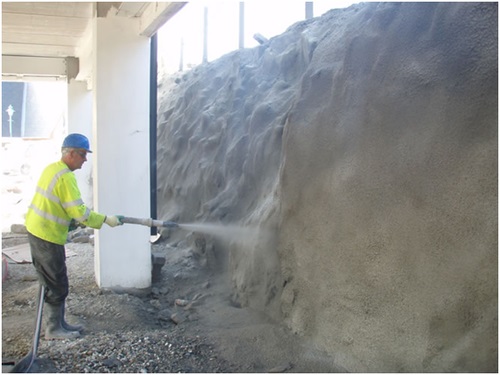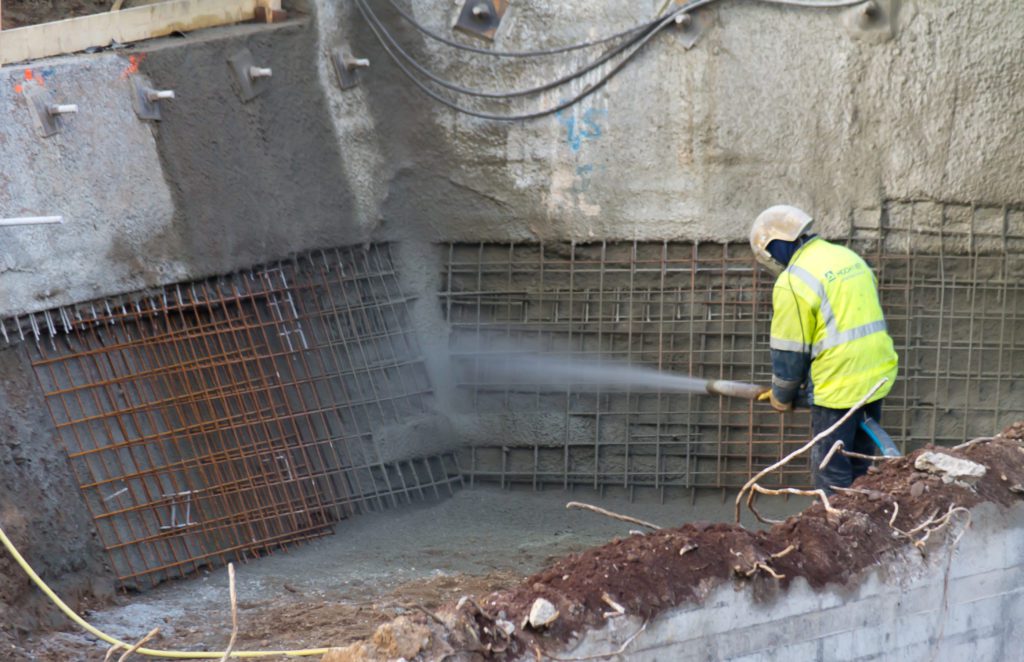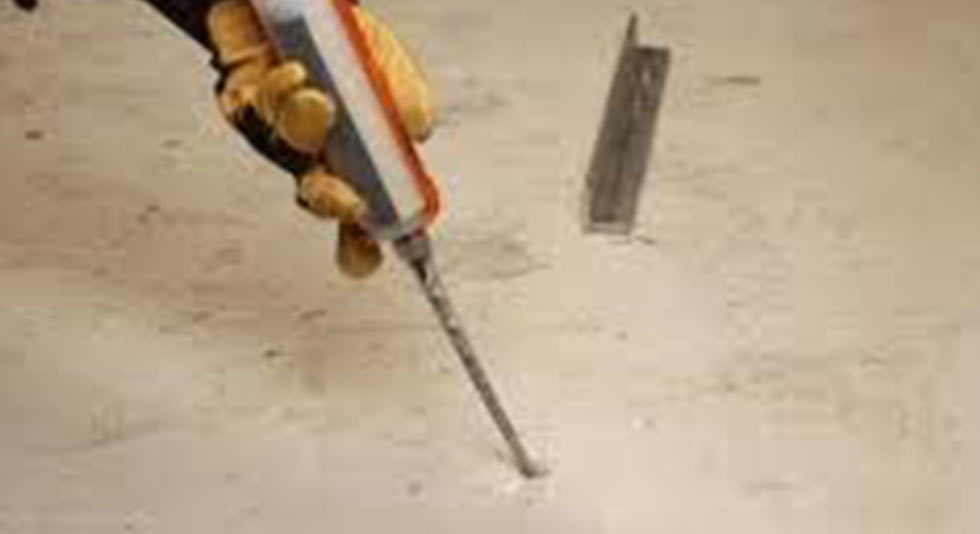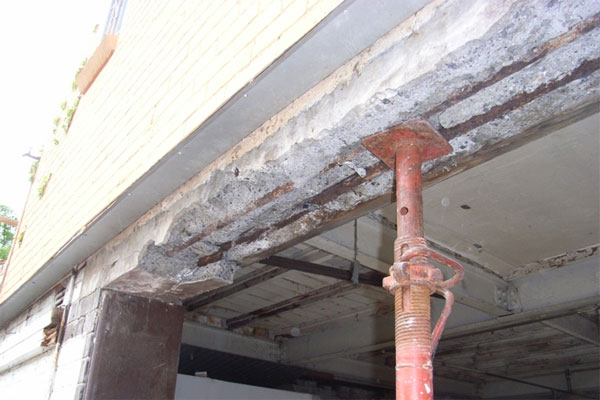Concrete can fail under compression, tension, torsion or flexure. Any failure is possible depending on the kind of loads under which the concrete is exposed. As concrete is weak in tension, tension failures are quite prominent and one needs to study fracture mechanics to understand the actual manner in which concrete fails. Material limitations, design and construction practices, and severe exposure conditions can cause concrete to deteriorate, which may result in aesthetic, functional, or structural problems. Concrete can deteriorate for a variety of reasons, and concrete damage is often the result of a combination of factors.
Despite its durability, concrete can be damaged and degraded by a long list of factors, such as-
- Insufficient reinforcement
- Chloride attack
- Chemical damage
- Carbonation
- Weather exposure
- Impact damage
- Excessive loads
- Structural damage
- Fire damage
- Seismic damage
- Blast damage
All structures, and all engineering products, will eventually fail overtime. Buildings, in particular, are not expected to last for a very long time without periodic maintenance. These periodic maintenance (which may occur for every 6months, a year or more) are carried out to put a check on all structural failures that could have surfaced on the structures during the time of its utilization (for whatever purpose it was built for). Engineers usually recognize the need to attend to failures on time before it results in catastrophes. In this regard, discussed below are few of the techniques of repair and rehabilitation of concrete structures.
Various types of retrofitting methods for repair and rehabilitation of concrete structure failure
Guniting
Guniting is mechanically applied material consisting of cement, aggregates and water. The cement and sand are batched and mixed in the usual way and conveyed through a hose pipe with the help of compressed air. A separate pipe line brings water under pressure and the water and cement aggregate mix are passed through and intimately mixed in a special manifold and then projected at high velocity to the surface being repaired.
Shotcreting
Shotcrete is defined as “mortar or concrete pneumatically projected at high speed onto a surface” (American Concrete Institute, 1990). There are two basic types of shotcrete—dry mix and wet mix. In dry mix shotcrete, the dry cement, sand, and coarse aggregate, if used, are premixed with only sufficient water to reduce dusting. The two types of shotcrete produce mixes with different water contents and different application characteristics as a result of the distinctly different mixing processes. Dry mix shotcrete suffers high dust generation and rebound losses varying from about 15 percent to up to 50 percent. Wet mix shotcrete must contain enough water to permit pumping through the delivery line.
Concrete Stitching
Stitching is a rehabilitation method used at cracks to maintain aggregate interlock and provide added reinforcement to minimize the relative movement of concrete slabs at the cracks. It is also used at the longitudinal joints to keep the slabs from separating. There are three types of stitching used; cross-stitching, slot-stitching, and U-bar stitching. The stitching procedure consists of drilling holes on both sides of the crack, cleaning the holes, and anchoring the legs of the staples in the holes, with either a non shrink grout or an epoxy resin-based bonding system.
Resin Injections
Resin Injections are designed for injecting cracks in concrete and masonry where there is a need to consolidate a structure or exclude water and air from contact with reinforcement. Cracks greater than 0.2mm in width are injected with Low Viscosity resins. If a crack is clean, free of impacted debris or paint, and 0.088 in. (2.2 mm) or greater in width, pack the epoxy into the crack. No surface preparation, other than perhaps blowing loose particles from the crack, is required. Work the resin (a slick gel works best) into the crack using a flexible metal or plastic spatula. The seal should be placed to a minimum depth of twice the crack width. Packing the seal is faster and easier than shaping a cap over the crack. It also consumes a fraction of the material, yet is stronger because the epoxy is bound in shear by the rough sides of the crack. In fact, the concrete will give way before a packed seal will. Another plus is that there is no protruding seal to be removed after injection.
Dry packing
This is the method of ramming into a confined area a mixture of portland cement, aggregate, and enough water to make it moist. It is usually used as a method of repair. Thorough curing is required. This method is used for repairing holes having a depth nearly equal to greater than the least surface dimension, i.e. for any holes and narrow slots cut for the repair of cracks. This method is not used for shallow depressions; for filling patches where reinforcement is exposed or holes which extend through and through walls or beams For better results and when water tightness is a requisite, the holes should be sharp and square at the surface edges, but corners within holes should be rounded. Holes for dry packs should have a minimum depth of 2.5 cm.
Polymer impregnation
Polymer impregnation has been proven to increase environmental and mechanical resistance of tuff (a soft volcanic rock), suggesting its potential application for restoration of monuments or reinforcement of structures. Polymer impregnated concrete is one of the widely used polymers composite. It is nothing but a conventional precast concrete, cured and dried in an oven or by dielectric heating from which the air in open cells is removed by vacuum process. Then a low viscosity liquid monomer or pre polymer partially or fully is impregnated or diffused into the pore system of the hardened cement composites or cement concrete and then polymerised using radiation or by the application of heat or by chemical initiation. The partial or surface impregnation improves the durability and chemical resistance, but the overall improvement in the structural properties is modest. On the other hand in depth or full impregnation improves structural properties considerably.
Vacuum impregnation
The metal casting process is very sophisticated, but it still has inherent imperfections. When liquefied and injected into a mold, metal creates gas bubbles that get trapped inside the molded form as the metal solidifies. Gas bubbles create air pockets, folds and inclusions. Depending on their size and their random placement within the casting, this porosity can cause metal parts to leak when placed under pressure. Herein comes, Vacuum impregnation. This technique seals porosity and leak paths that form during the casting or molding process. Vacuum impregnation stops casting porosity and allows manufacturers to use parts that would otherwise be scrapped. Vacuum impregnation is the preferred method to seal porosity in order to prevent fluids or gases from leaking under pressure.
Autogenous healing
Autogenous healing is the natural process of crack repair that can occur in concrete in the presence of moisture, and the absence of tensile stress. The repair is by a combination of mechanical blocking by particles carried into the crack with the water and the deposition of calcium carbonate from the cementitious material. Autogenous healing has practical applications for closing dormant cracks in a moist environment, such as may be found in mass structures and in water retaining or watertight structures.
Drilling and plugging
This method consists of drilling down the length of the crack and grouting it to form a key. A hole, typically 50 to 75 mm in diameter should be drilled, centered on and following the crack. The drilled hole is then cleaned, made tight and filled with grout. The grout key prevents transverse movements of the sections of concrete adjacent to the crack. The key will also reduce heavy leakage through the crack and loss of soil from behind a leaking wall. When structural strength is not the criteria but water- tightness is essential, the drilled hole, should be filled with a resilient material of low modulus in lieu of grout. If the keying effect is essential, the resilient material can be placed in a second hole, the first being grouted.






Epoxy injection
The injection procedure will depend on the application and location of the crack. Horizontal, vertical, and overhead cracks require different approaches. Size and accessibility of the crack shall also be considered. Depending on the specific requirements of the job, crack repair by epoxy injection can restore structural integrity and reduce moisture penetration through concrete cracks. As for all repair procedures, surface preparation is the key to crack injection. Depending on the condition and location of cracks it must be cleaned from foreign matter and any loose or damaged concrete shall be removed. The surface where the injection takes place must be strong to take the pressure of the injected resin. Proper sealing of the crack surface is necessary to avoid losses during injection. Follow the instructions, given in the manufacturer’s product literature.
Polymer concrete composite usage
Polymer concretes are a type of concrete that use polymers to replace lime-type cements as a binder. In some cases the polymer is used in addition to portland cement to form Polymer Cement Concrete (PCC) or Polymer Modified Concrete (PMC). Polymer concrete may be used for new construction or repairing of old concrete. The adhesive properties of polymer concrete allow repair of both polymer and conventional cement-based concretes. The corrosion resistance and low permeability of polymer concrete allows it to be used in swimming pools, sewer structure applications, drainage channels, electrolytic cells for base metal recovery, and other structures that contain liquids or corrosive chemicals. It is especially suited to the construction and rehabilitation of manholes due to their ability to withstand toxic and corrosive sewer gases and bacteria commonly found in sewer systems. Unlike traditional concrete structures, polymer concrete requires no coating or welding of PVC-protected seams. It can also be used as a bonded wearing course for asphalt pavement, for higher durability and higher strength upon a concrete substrate, and in skate parks, as it is a very smooth surface. Polymer concrete has historically not been widely adopted due to the high costs and difficulty associated with traditional manufacturing techniques. However, recent progress has led to significant reductions in cost, meaning that the use of polymer concrete is gradually becoming more widespread.
Concrete sealer usage
Concrete sealers are applied to concrete to protect it from surface damage, corrosion, and staining. They either block the pores in the concrete to reduce absorption of water and salts or form an impermeable layer which prevents such materials from passing. In past decades attempts to protect concrete have included sealers ranging from wax to linseed oil. Today, high quality concrete sealers can block up to 99% of surface moisture. There are two main sealer categories: topical sealers (coatings) and penetrating sealers (reactive).
Topical Sealers can provide visual enhancement as well as topical protection from stains and chemicals. They require a dry, clean surface during application to gain adhesion. Topical sealers may alter the coefficient of friction which can make substrates slick when wet – a condition that can be remedied by adding anti-skid materials. Life span is generally 1-5 years, although high-end epoxy/urethane systems can last significantly longer. Penetrating sealers can be applied to dry or damp surfaces and should be properly matched with substrate porosity in order to effectively penetrate the surface and react. The chemical reaction bonds active ingredients within the substrate blocking surface moisture. Penetrating sealers generally do not significantly modify substrate appearance or traction.
Fiber-reinforced concrete
Fiber-reinforced concrete (FRC) is concrete containing fibrous material which increases its structural integrity. It contains short discrete fibers that are uniformly distributed and randomly oriented. Fibers include steel fibers, glass fibers, synthetic fibers, natural fibers and many more – each of which lend varying properties to the concrete. In addition, the character of fiber-reinforced concrete changes with varying concretes, fiber materials, geometries, distribution, orientation, and densities. Fibers are usually used in concrete to control cracking due to plastic shrinkage and to drying shrinkage. They also reduce the permeability of concrete and thus reduce bleeding of water. Some types of fibers produce greater impact, abrasion, and shatter–resistance in concrete. Generally fibers do not increase the flexural strength of concrete, and so cannot replace moment–resisting or structural steel reinforcement. Indeed, some fibers actually reduce the strength of concrete
Routing and Sealing
This is a common technique for crack treatment and is relatively simple in comparison to the procedures and the training required for epoxy injection. The procedure is most applicable to flat horizontal surfaces such as floors and pavements. However, this method can be accomplished on vertical surfaces as well as on curved surfaces. This technique is used to repair both fine pattern cracks and larger, isolated cracks. A common and effective use is for waterproofing by sealing cracks on the concrete surface where water stands, or where hydrostatic pressure is applied.
The sealant may be of several materials, including epoxies, silicones, urethanes, polysulfides, asphaltic materials and polymer mortars. Cement grouts should be avoided due to the likelihood of cracking. For floors, the sealant should be sufficiently rigid to support the anticipated traffic. The procedure consists of preparing a groove at the surface ranging in depth, typically from 6 to 25 mm. A concrete saw, hand tools or pneumatic tools may be used. This groove is then cleaned by plastic or sir blasting and allowed to dry. A sealant is placed into the dry groove and allowed to cure.
Strengthening of existing structure
The seismic behaviour of old existing buildings is affected by their original structural inadequacies, material degradation due to time, and alterations carried out during use over the years such as making new openings, addition of new parts inducing dissymmetry in plan and elevation, etc.
Commonly, strengthening procedures should aim at one or more of the following objectives, which are- increasing the lateral strength in one or both directions, by reinforcement or by increasing wall areas or the number of walls and columns, giving unity to the structure by providing a proper connection between its resisting elements, in such a way that inertia forces generated by the vibration of the building can be transmitted to the members that have the ability to resist them, eliminating features that are sources of weakness or that produce concentrations of stresses in some members. Asymmetrical plan distribution of resisting members, abrupt changes of stiffness from one floor to the other and avoiding the possibility of brittle modes of failure by proper reinforcement and connection of resisting members.
Cracking Repair by Prestressing Steel
When a major portion of a member is to be strengthened, or a crack is to be closed, post- tensioning is often the desirable solution. The technique uses prestressing strands or bars to apply a compressive force. Adequate anchorage must be provided for the prestressing steel. The method of correction is crack in slab and beam.
Chemical Grouting
Chemicals used for grouting are sodium silicates, urethanes and acrylamides. Two or more chemicals are combined to form gel, a solid precipitate or a foam as opposed to cement grouts that consist of suspension of solids particles in a fluid. The advantages of chemical grouts include applicability in moist environments and their ability to be applied in very fine cracks.
Column Jacketing
Column Jacketing is done to improve the load carrying capacity of the column. The procedure followed is: Open the footing of the column by excavating soil around it. • Remove the plaster from the surface of the column. Make the surface of column concrete rough by sand blasting. • Remove the corroded bars by cutting them. Add new bars from footing to the slab as per the instruction of engineers. Apply bonding agent on the old concrete for proper bonding between old and new concrete. Erect necessary shuttering around the column. • Pour minimum M-25 grade of concrete, vibrate and cure it.
Beam Jacketing
Before taking up the strengthening of a beam, the load acting on it should be reduced by removing the flooring tiles and bed mortar from the slab. Props are erected to support the slab. After clipping off the existing plaster on the beam, additional longitudinal bars at the bottom of the beam to- geather with new stirrups are provided. Stirrups are inserted by making holes from the slab. The longitudinal bars are passed through the supporting columns through holes of appropriate diameter drilled in the columns. The spaces between bars and surrounding holes are filled with epoxy grout to ensure a good bond.
Carbon wrapping
Carbon wrapping for columns is used to strengthen the RCC structures like columns, beams, slabs etc. Carbon wrapping for columns has very high tensile strength, is lightweight & non corrosive, making it the most effective choice for structural repairs. Using carbon fibre concrete repair is also cost effective as repair time required is very less as compared to other methods, thereby minimizing the overall cost of the project. Also the cost of heavy equipment is eliminated making it more cost effective.
Carbon wrapping for columns is strengthening concrete repair is ideal for plates whereas requisition of high strength, light weight and earthquake resistant structures are required. Carbon fibers have high tensile strength and young’s modulus, but also a high specific strength compared to steel and glass fibers for Carbon wrapping for columns.
Conclusion
Concrete is typically designed for the compressive strength and has significantly lower tensile strength. If the internal tensile stresses are greater than the tensile strength of the concrete, a crack can develop. Excess water in the concrete mix can also increase the probability of cracking. When placing the concrete, avoid adding extra water to the mix. The excess water will evaporate from the concrete which will lead to increased shrinkage. Make sure that you choose the proper concrete mix for your project. If any disruption appears on your concrete structure, choose the retrofitting method best fitted for your work, with expert advice.

